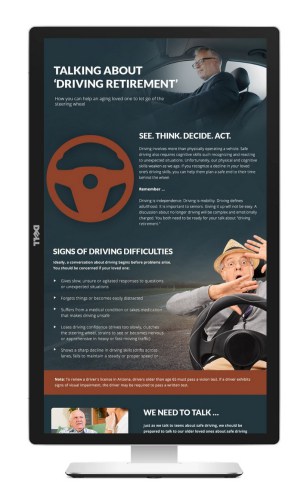Having the talk about driving retirement
Learn the best way to communicate about when elderly should stop driving
Talking about driving retirement can be difficult. As you know, driving requires a specific physical and mental skill set that allows you the ability to react in unexpected scenarios. Since this is the case, driving can become a dangerous task for someone who has noticed a decline in their physical and cognitive skills. This tends to happen as we age and experience certain limitations. Which is why this infographic strives to offer assistance in having the conversation of driving retirement.
Notice the signs
One of the first things to keep in mind is the flexibility and independence that driving offers. To simply give up driving would feel like a luxury is being lost. As expected, this conversation would not be an easy one.
To be clear, a conversation about driving retirement should take place when family members or friends show signs of driving difficulties. Here are a few signs to make note of :
- Slow and unsure responses to unexpected situations
- Becomes forgetful and easily distracted
- Suffers from a medical condition
- Takes medication that can make driving unsafe
- Loss of confidence in driving
- Nervousness
- Decline in driving ability
Having "the talk"
As children of an aging parent with these signs you take on a role unlike before. Just as they had a discussion about driving when you were a teen, you need to be just as prepared to have a discussion about their safe driving habits. If you notice these signs, be sure to act with these helpful tips:
- Making talking about it a priority
- Let the conversation be a reoccurring one instead of a closed one-time conversation
- Approach the subject matter in a one-on-one setting so that everyone is comfortable
- Allow the conversation to be a two-way conversation
- Elaborate on the importance of their safety and independence
- Be sure to cite specific reasons for your concerns
- Offer alternatives
The last point of this conversation could be one of the best options to include in your conversation. It offers them alternative methods of transportation. Providing options can make the conversation feel more positive and allow transportation to continue through alternative transportation programs such as Senior Ride, Senior Center Shuttle, ADA Ride, Employment Transportation, and Medical Trip program.
This infographic offers helpful insight into having this conversation, but it also provides helpful facts to include. In fact, the AAA Foundation for Traffic Safety offers helpful topics to include in your discussion. For instance, more than 200,000 drivers ages 65 and older were injured and more than 3,500 were killed in traffic accidents in 2016.
In 2017 there were more than 23,000 drivers 65 years and older that were in Arizona. This caused 187 deaths and more than 7,500 injuries. The AAA Foundation also points out that experts suggest that seniors "plan for driving retirement at the same time they begin planning retirement from their work."
Implementing helpful facts and alternative options in your conversation will be a great way to lead the conversation, but one of the major factors mentioned in the infographic is to allow your elderly loved to let their voice be heard.

